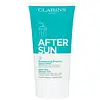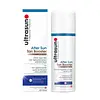What's inside
What's inside
 Key Ingredients
Key Ingredients

 Benefits
Benefits

 Concerns
Concerns

 Ingredients Side-by-side
Ingredients Side-by-side

Water
Skin ConditioningDibutyl Adipate
EmollientDicaprylyl Carbonate
EmollientDiethylamino Hydroxybenzoyl Hexyl Benzoate
UV FilterHomosalate
Skin ConditioningOctocrylene
UV AbsorberAlcohol
AntimicrobialButyloctyl Salicylate
Skin ConditioningEthylhexyl Salicylate
UV AbsorberEthylhexyl Triazone
UV AbsorberGlycerin
HumectantBis-Ethylhexyloxyphenol Methoxyphenyl Triazine
Skin ConditioningPhenylbenzimidazole Sulfonic Acid
UV AbsorberTromethamine
BufferingPolyester-7
Skin ConditioningParfum
MaskingPolysilicone-15
UV FilterNeopentyl Glycol Diheptanoate
EmollientCalophyllum Inophyllum Seed Oil
AntimicrobialSodium Chloride
MaskingTocopheryl Acetate
AntioxidantPentylene Glycol
Skin ConditioningEthylene Brassylate
MaskingTamarindus Indica Seed Gum
Emulsion StabilisingDisodium EDTA
Citric Acid
BufferingAloe Barbadensis Leaf Juice
Skin ConditioningButylene Glycol
HumectantCapsicum Annuum Fruit Extract
AntimicrobialCassia Alata Leaf Extract
AstringentPhenoxyethanol
PreservativePlatanus Occidentalis Bark Extract
Skin ProtectingHelianthus Annuus Seed Oil
EmollientTocopherol
AntioxidantPotassium Sorbate
PreservativeRosmarinus Officinalis Leaf Extract
AntimicrobialSodium Benzoate
MaskingWater, Dibutyl Adipate, Dicaprylyl Carbonate, Diethylamino Hydroxybenzoyl Hexyl Benzoate, Homosalate, Octocrylene, Alcohol, Butyloctyl Salicylate, Ethylhexyl Salicylate, Ethylhexyl Triazone, Glycerin, Bis-Ethylhexyloxyphenol Methoxyphenyl Triazine, Phenylbenzimidazole Sulfonic Acid, Tromethamine, Polyester-7, Parfum, Polysilicone-15, Neopentyl Glycol Diheptanoate, Calophyllum Inophyllum Seed Oil, Sodium Chloride, Tocopheryl Acetate, Pentylene Glycol, Ethylene Brassylate, Tamarindus Indica Seed Gum, Disodium EDTA, Citric Acid, Aloe Barbadensis Leaf Juice, Butylene Glycol, Capsicum Annuum Fruit Extract, Cassia Alata Leaf Extract, Phenoxyethanol, Platanus Occidentalis Bark Extract, Helianthus Annuus Seed Oil, Tocopherol, Potassium Sorbate, Rosmarinus Officinalis Leaf Extract, Sodium Benzoate
Water
Skin ConditioningGlycerin
HumectantAlcohol
AntimicrobialIsoamyl Laurate
EmollientDihydroxyacetone
Skin ConditioningIsosorbide Dicaprylate
Skin ConditioningPolyacrylate Crosspolymer-6
Emulsion StabilisingMenthyl PCA
HumectantEthylhexylglycerin
Skin ConditioningXanthan Gum
EmulsifyingAllantoin
Skin ConditioningSodium Metabisulfite
AntioxidantBisabolol
MaskingParfum
MaskingMagnesium Stearate
Cosmetic ColorantTocopheryl Acetate
AntioxidantT-Butyl Alcohol
PerfumingHexyl Cinnamal
PerfumingLimonene
PerfumingBenzyl Salicylate
PerfumingWater, Glycerin, Alcohol, Isoamyl Laurate, Dihydroxyacetone, Isosorbide Dicaprylate, Polyacrylate Crosspolymer-6, Menthyl PCA, Ethylhexylglycerin, Xanthan Gum, Allantoin, Sodium Metabisulfite, Bisabolol, Parfum, Magnesium Stearate, Tocopheryl Acetate, T-Butyl Alcohol, Hexyl Cinnamal, Limonene, Benzyl Salicylate
Ingredients Explained
These ingredients are found in both products.
Ingredients higher up in an ingredient list are typically present in a larger amount.
Alcohol comes in many different forms. Different types of alcohol will have different effects on skin. This ingredient is usually an astringent alcohol.
These alcohols are drying on the skin. They may strip away your skin's natural oils and even damage your skin barrier. Astringent alcohols may also irritate skin.
Other types of astringent alcohols include:
According to the National Rosacea Society based in the US, you should be mindful of products with these alcohols in the top half of ingredients.
Any type of sanitizing product will have high amounts of alcohol to help kill bacteria and viruses.
Fatty alcohols come from plant oils such as coconut oil. These can help hydrate the skin and are non-irritating. Some fatty alcohols include cetyl and stearyl alcohol.
Learn more about AlcoholGlycerin is already naturally found in your skin. It helps moisturize and protect your skin.
A study from 2016 found glycerin to be more effective as a humectant than AHAs and hyaluronic acid.
As a humectant, it helps the skin stay hydrated by pulling moisture to your skin. The low molecular weight of glycerin allows it to pull moisture into the deeper layers of your skin.
Hydrated skin improves your skin barrier; Your skin barrier helps protect against irritants and bacteria.
Glycerin has also been found to have antimicrobial and antiviral properties. Due to these properties, glycerin is often used in wound and burn treatments.
In cosmetics, glycerin is usually derived from plants such as soybean or palm. However, it can also be sourced from animals, such as tallow or animal fat.
This ingredient is organic, colorless, odorless, and non-toxic.
Glycerin is the name for this ingredient in American English. British English uses Glycerol/Glycerine.
Learn more about GlycerinParfum is a catch-all term for an ingredient or more that is used to give a scent to products.
Also called "fragrance", this ingredient can be a blend of hundreds of chemicals or plant oils. This means every product with "fragrance" or "parfum" in the ingredients list is a different mixture.
For instance, Habanolide is a proprietary trade name for a specific aroma chemical. When used as a fragrance ingredient in cosmetics, most aroma chemicals fall under the broad labeling category of “FRAGRANCE” or “PARFUM” according to EU and US regulations.
The term 'parfum' or 'fragrance' is not regulated in many countries. In many cases, it is up to the brand to define this term.
For instance, many brands choose to label themselves as "fragrance-free" because they are not using synthetic fragrances. However, their products may still contain ingredients such as essential oils that are considered a fragrance by INCI standards.
One example is Calendula flower extract. Calendula is an essential oil that still imparts a scent or 'fragrance'.
Depending on the blend, the ingredients in the mixture can cause allergies and sensitivities on the skin. Some ingredients that are known EU allergens include linalool and citronellol.
Parfum can also be used to mask or cover an unpleasant scent.
The bottom line is: not all fragrances/parfum/ingredients are created equally. If you are worried about fragrances, we recommend taking a closer look at an ingredient. And of course, we always recommend speaking with a professional.
Learn more about ParfumTocopheryl Acetate is AKA Vitamin E. It is an antioxidant and protects your skin from free radicals. Free radicals damage the skin by breaking down collagen.
One study found using Tocopheryl Acetate with Vitamin C decreased the number of sunburned cells.
Tocopheryl Acetate is commonly found in both skincare and dietary supplements.
Learn more about Tocopheryl AcetateWater. It's the most common cosmetic ingredient of all. You'll usually see it at the top of ingredient lists, meaning that it makes up the largest part of the product.
So why is it so popular? Water most often acts as a solvent - this means that it helps dissolve other ingredients into the formulation.
You'll also recognize water as that liquid we all need to stay alive. If you see this, drink a glass of water. Stay hydrated!
Learn more about Water